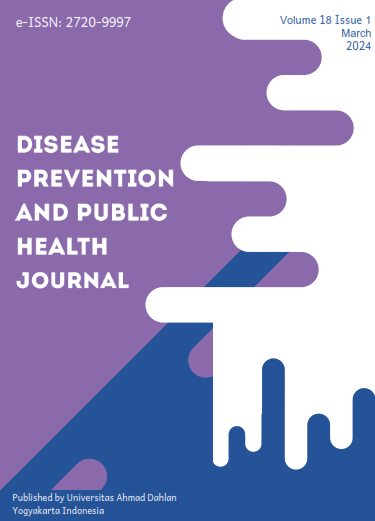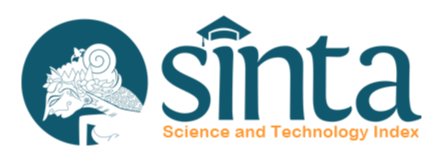Management of Breast and Nipple Problems in Breastfeeding Mothers: Systematic Review
Management of Breast and Nipple Problems in Breastfeeding Mothers
DOI:
https://doi.org/10.12928/dpphj.v18i1.10274Keywords:
Breast problem, Nipple problem, BreastfeedingAbstract
Introduction: Problems in the breasts and nipple are commonly faced by mothers which affects breastfeeding process. Appropriate and suitable intervention for breast and nipple problems that occur is one of the competencies both health workers and mothers must know
Objective: To identify and explain breast and nipple problems that occur in breastfeeding mothers. 6 electronic databases were used; Science Direct, ProQuest, Springer Link, Taylor & Francis Online, Clinical Key Nursing, and Google Scholar.
Results: There were 12 articles (sample 1,980) with breast and nipple problems in breastfeeding mothers there are breast engorgement (65%), breast pain (52.5%), plugged milk ducts (45.9%), nipple pain (15.5%), mastitis (10.5%), cracks and lesions on the nipple (9.7%), inverted nipple (4.2%), and breast abscess (0.6%). Five Steps Systematic Therapy (FSST) intervention can overcome breast pain, breast engorgement, mastitis, plugged milk ducts. Low-Level Laser Therapy can treat pain, cracks and nipple lesions. Reverse pressure softening technique can treat breast engorgement. Therapeutic breast massage can treat breast pain, breast engorgement, plugged milk ducts. Integrated Breast Massage can treat plugged milk ducts. Hoffman exercise and inverted syringe can correct inverted. Ultrasound-guided percutaneous catheters and hydrostatic pressure irrigation can treat breast abscesses. Lanolin, breast milk, aloe vera and olive oil were effective in treating pain, cracks and nipple lesions; Cold cabbage can treat breast pain and breast swelling.
Conclusion: Breast and nipple problems in breastfeeding mothers can be addressed with all interventions.
References
Karaçam Z, Sağlık M. Breastfeeding problems and interventions performed on problems: Systematic review based on studies made in Turkey. Turk Pediatr Ars [Internet]. 2018;53(3):134–48. Available from: https://www.scopus.com/inward/record.uri?eid=2-s2.0-85057223459&doi=10.5152%2FTurkPediatriArs.2018.6350&partnerID=40&md5=163664450ea363ec00f78b66dbe09ea5
Warkentin T, Hermann S, Berndl A. Breastfeeding positions and techniques used by Canadians with physical disabilities. Disabil Health J [Internet]. 2021;14(4):101151. Available from: https://doi.org/10.1016/j.dhjo.2021.101151
Westerfield KL, Koenig K, Oh R. Breastfeeding: Common questions and answers. Am Fam Physician. 2018;98(6):368–73.
Ahmed SOM, Hamid HIA, Jothi Shanmugam A, Tia MMG, Alnassry SMA. Impact of exclusive breastfeeding on physical growth. Clin Nutr Open Sci [Internet]. 2023;49:101–6. Available from: https://doi.org/10.1016/j.nutos.2023.04.008
Kemenkes RI. Temu Media Pekan Menyusui Sedunia Tahun 2023. Enabling Brestfeeding. 2023;1–10.
Unicef. World breastfeeding week: UNICEF and WHO call for greater support for breastfeeding in Indonesia as breastfeeding rates decline during the Covid-19 pandemic [internet]. 2022 [cited 2023 Des 01]. Available from: https://www.unicef.org/indonesia/id/siaran-pers/pekan-menyusui-sedunia-unicef-dan-who-serukan-dukungan-yang-besar-besar-terhadap
Najem, B. and Al-Deen D. Breast Feeding Problems in Primipara Mothers in Early Postnatal Period Results : Iraqi J Comm Med. 2011;24(3):1.
Safari JG, Kimambo SC, Lwelamira JE. Feeding practices and nutritional status of infants in Morogoro municipality, Tanzania. Tanzan J Health Res. 2013;15(3):1–10.
Abdallah NMA, Eldin SAN, Gad AH. Breast and Nipple Problems Encountered among Puerperal Primipara Women in Zagazig. Available online www.ijpras.com Int J Pharm Res Allied Sci [Internet]. 2018;7(1):183–95. Available from: www.ijpras.com
Tasnim S, Roy SK, Jahan K, Nazmeen S, Debnath SC, Islam ABMM. Difficulties in breastfeeding: Easy solution by oketani breast massage. Bangladesh Med Res Counc Bull [Internet]. 2019;45(3):149–54. Available from: https://www.scopus.com/inward/record.uri?eid=2-s2.0-85090648530&doi=10.3329%2FBMRCB.V45I3.44644&partnerID=40&md5=f26600a547fa1624e4283692e2b4cabc
Babakazo P, Bosonkie M, Mafuta E, Mvuama N, Mapatano MA. Common breastfeeding problems experienced by lactating mothers during the first six months in Kinshasa. PLoS One. 2022;17(10 October):1–12.
Yao Y, Long T, Pan Y, Li Y, Wu L, Fu B, et al. A Five-step Systematic Therapy for Treating Plugged Ducts and Mastitis in Breastfeeding Women: A Case–Control Study. Asian Nurs Res (Korean Soc Nurs Sci) [Internet]. 2021;15(3):197–202. Available from: https://doi.org/10.1016/j.anr.2021.04.001
Mounika M, Kalabarathi S, Padmapriya D. Effectiveness of reverse presure softening technique on level of breast engorgement among postpartum mothers at Saveetha Medical College and Hospital, Thandalam, Chennai. Cardiometry. 2023;(25):231–7.
Munsittikul N, Tantaobharse S, Siripattanapipong P, Wutthigate P, Ngerncham S, Yangthara B. Integrated breast massage versus traditional breast massage for treatment of plugged milk duct in lactating women: a randomized controlled trial. Int Breastfeed J [Internet]. 2022;17(1):1–10. Available from: https://doi.org/10.1186/s13006-022-00485-6
Thurkkada AP, Rajasekharan Nair S, Thomas S, Sreelekha P, Sanu SK, Chandran PR, et al. Effectiveness of Hoffman’s Exercise in Postnatal Mothers With Grade 1 Inverted Nipples. J Hum Lact. 2023;39(1):69–75.
Perić O, Pavičić Bošnjak A, Mabić M, Tomić V. Comparison of Lanolin and Human Milk Treatment of Painful and Damaged Nipples: A Randomized Control Trial. J Hum Lact. 2023;39(2):236–44.
Kaya Ö, Tecik S, Suzan ÖK, Kabul F, Koyuncu O, Çınar N. The effect of interventions on flat and inverted nipple on breastfeeding: A systematic review. J Pediatr Nurs. 2023;(August):1–6.
Witt AM, Bolman M, Kredit S, Vanic A. Therapeutic Breast Massage in Lactation for the Management of Engorgement, Plugged Ducts, and Mastitis. J Hum Lact. 2016;32(1):123–31.
Umesh Bagal S, Salunkhe JA, Salunkhe AH, Kakade S V, Mohite VR, Jyoti M, et al. A Comparative Study to Assess Problem of Inverted Nipple and Its Relationship to Successful Breast Feeding Among Antenatal Mothers. Int J Heal Sci Res [Internet]. 2017;7(4):280. Available from: www.ijhsr.org
Tateoka Y. Effectiveness of aloe fomentation for nipple-related complications during the early puerperium period: a randomized, controlled, interventional study. BMC Res Notes [Internet]. 2022;15(1):1–5. Available from: https://doi.org/10.1186/s13104-022-05980-x
Du Z, Liu L, Qi X, Gao P, Wang S. Treatment of lactational breast abscesses with cavity diameter larger than 5 cm via combined ultrasonography-guided percutaneous catheter placement and hydrostatic pressure irrigation. J Obstet Gynaecol (Lahore) [Internet]. 2022;42(3):385–8. Available from: https://doi.org/10.1080/01443615.2021.1907558
Coca KP, Marcacine KO, Gamba MA, Corrêa L, Aranha ACC, Abrão ACF de V. Efficacy of Low-Level Laser Therapy in Relieving Nipple Pain in Breastfeeding Women: A Triple-Blind, Randomized, Controlled Trial. Pain Manag Nurs. 2016;17(4):281–9.
Wong BB, Chan YH, Leow MQH, Lu Y, Chong YS, Koh SSL, et al. Application of cabbage leaves compared to gel packs for mothers with breast engorgement: Randomised controlled trial. Int J Nurs Stud. 2017;76(July 2017):92–9.
Flagg JA, Busch DW. Utilizing a Risk Factor Approach to Identify Potential Breastfeeding Problems. Glob Pediatr Heal. 2019;6:0–4.
Mathur NB, Dhingra D. Breastfeeding. Indian J Pediatr. 2014;81(2):143–9.
Suresh S, Sharma KK, Saksena M, Thukral A, Agarwal R, Vatsa M. Predictors of breastfeeding problems in the first postnatal week and its effect on exclusive breastfeeding rate at six months: experience in a tertiary care centre in Northern India. Indian J Public Health. 2014;58(4):270–3.
Dash M. Intervention Strategies for Successful Breast Feeding: Randomized Clinical Trial. Acad J Pediatr Neonatol. 2017;3(1):3–6.
Bourdillon K, McCausland T, Jones S. Latch-related nipple pain in breastfeeding women: The impact on breastfeeding outcomes. Br J Midwifery. 2020;28(7):406–14.
Lucas R, Bernier K, Perry M, Evans H, Ramesh D, Young E, et al. Promoting self-management of breast and nipple pain in breastfeeding women: Protocol of a pilot randomized controlled trial. Res Nurs Heal. 2019;42(3):176–88.
Chung H, Dai T, Sharma SK, Huang YY, Carroll JD, Hamblin MR. The nuts and bolts of low-level laser (Light) therapy. Ann Biomed Eng. 2012;40(2):516–33.
Yao Y, Long T, Pan Y, Li Y, Wu L, Fu B, et al. A Five-step Systematic Therapy for Treating Plugged Ducts and Mastitis in Breastfeeding Women: A Case–Control Study. Asian Nurs Res (Korean Soc Nurs Sci) [Internet]. 2021;15(3):197–202. Available from: https://doi.org/10.1016/j.anr.2021.04.001
Sullivan D. The breastfeeding mom’s guide to using cabbage leaves [internet]. 2020 [cited 2023 Des 01]. Available from:https://www.healthline.com/health/breastfeeding/cabbage-leaves
Kent JC, Ashton E, Hardwick CM, Rowan MK, Chia ES, Fairclough KA, et al. Nipple pain in breastfeeding mothers: Incidence, causes and treatments. Int J Environ Res Public Health. 2015;12(10):12247–63.
Niazi A, Rahimi VB, Soheili-Far S, Askari N, Rahmanian-Devin P, Sanei-Far Z, et al. A systematic review on prevention and treatment of nipple pain and fissure: Are they curable? J Pharmacopuncture. 2018;21(3):139–50.
Scanes CG. Chapter 2 - Animal Attributes Exploited by Humans (Nonfood Uses of Animals). In: Scanes CG, Toukhsati SRBT-A and HS, editors. Academic Press; 2018. p. 13–40. Available from: https://www.sciencedirect.com/science/article/pii/B9780128052471000022
American Cancer Society. (2022). Non-cancerous Breast Conditions Fibrocystic Changes in the Breast. Acs, 1–29. https://www.cancer.org/cancer/breast-cancer/non-cancerous-breast-conditions.html
Luo J, Long T, Cai Y, Teng Y, Fan Z, Liang Z, et al. Abscess drainage with or without antibiotics in lactational breast abscess: Study protocol for a randomized controlled trial. Infect Drug Resist. 2020;13:183–90.
Colin C, Delov AG, Peyron-Faure N, Rabilloud M, Charlot M. Breast abscesses in lactating women: evidences for ultrasound-guided percutaneous drainage to avoid surgery. Emerg Radiol. 2019;26(5):507–14.
Dahl L. Clinician’s Guide to Breastfeeding Evidenced-based Evaluation and Management. 2015. 168 p.
Zucca-Matthes G, Urban C, Vallejo A. Anatomy of the nipple and breast ducts. Gland Surg. 2016;5(1):32–6.
Rao DN, Winters R. Inverted Nipple. 2022;1–7.
Godfrey S. Submitted DT. Effectiveness of Hoffman’S Exercise on Level of Breastfeeding Among Postnatal Mothers With Nipple Defects in Selected Hospitals, Kanyakumari District in Partial Fulfilment of the Requirement for the Degree of Master of Science in Nursing Obstetrics and Gy. 2014;(April):1–82.
Kaur A et al. A Study to Evaluate the Effectiveness of Hoffman’s Excercise on Succesfull Breastfeeding among Antenatal Mothers with Nipple Defects at Sri Guru. Int J Heal Sci Res. 2020;10(March):121–8.
Zainiyah H, Wahyuningtyas D, Astriani R. Keberhasilan Puting Susu Menonjol Dengan Menggunakan Metode Modifikasi Spuit Injeksi pada Ibu Post Partum. Psnkh [Internet]. 2019;05(1):135–45. Available from: http://jurnal.akeskhjogja.ac.id/index.php/PSN/issue/view/30
Puapornpong P, Raungrongmorakot K, Paritakul P, Ketsuwan S, Wongin S. Nipple length and its relation to success in breastfeeding. J Med Assoc Thail. 2013;96(SUPPL.1):6–9.
Ismail NIAA, Hafez SK, Ghaly AS. Effect of Breast Milk, Peppermint Water and Breast Shell on Treatment of Traumatic Nipple in Puerperal Lactating Mothers. Int J Nov Res Healthc Nurs. 2019;6(3):692–709.
Downloads
Published
Issue
Section
License
Copyright (c) 2024 Universitas Ahmad Dahlan

This work is licensed under a Creative Commons Attribution-ShareAlike 4.0 International License.
Authors transfer the copyright and grant the Disease Prevention and Public Health Journal right of first publication with the work simultaneously licensed under a Creative Commons Attribution License (CC BY-SA 4.0) that allows others to share (copy and redistribute the material in any medium or format) and adapt (remix, transform, and build upon the material) the work for any purpose, even commercially with an acknowledgement of the work's authorship and initial publication in Disease Prevention and Public Health Journal. Authors are able to enter into separate, additional contractual arrangements for the non-exclusive distribution of the journal's published version of the work (e.g., post it to an institutional repository or publish it in a book), with an acknowledgement of its initial publication in Disease Prevention and Public Health Journal. Authors are permitted and encouraged to post their work online (e.g., in institutional repositories or on their website) prior to and during the submission process, as it can lead to productive exchanges, as well as earlier and greater citation of published work (See The Effect of Open Access).

This work is licensed under a Creative Commons Attribution-ShareAlike 4.0 International License.







